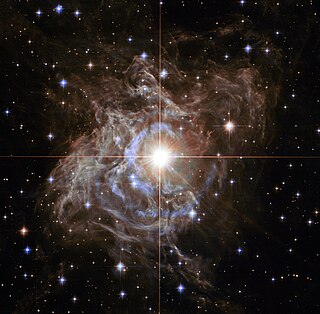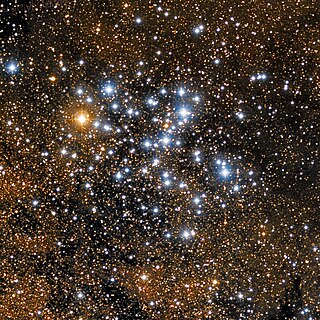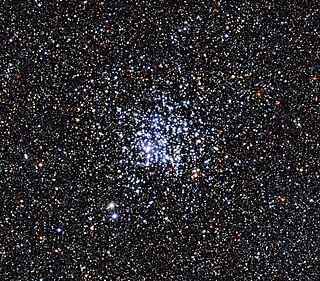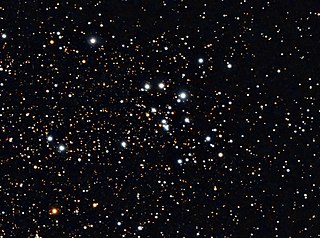
Star clusters are large groups of stars held together by self-gravitation. Two main types of star clusters can be distinguished. Globular clusters are tight groups of ten thousand to millions of old stars which are gravitationally bound. Open clusters are more loosely clustered groups of stars, generally containing fewer than a few hundred members, that are often very young. As they move through the galaxy, over time, open clusters become disrupted by the gravitational influence of giant molecular clouds. Even though they are no longer gravitationally bound, they will continue to move in broadly the same direction through space and are then known as stellar associations, sometimes referred to as moving groups.

A Cepheid variable is a type of variable star that pulsates radially, varying in both diameter and temperature. It changes in brightness, with a well-defined stable period and amplitude. Cepheids are important cosmic benchmarks for scaling galactic and extragalactic distances; a strong direct relationship exists between a Cepheid variable's luminosity and its pulsation period.

RR Lyrae variables are periodic variable stars, commonly found in globular clusters. They are used as standard candles to measure (extra) galactic distances, assisting with the cosmic distance ladder. This class is named after the prototype and brightest example, RR Lyrae.

Messier 4 or M4 is a globular cluster in the constellation of Scorpius. It was discovered by Philippe Loys de Chéseaux in 1745 and catalogued by Charles Messier in 1764. It was the first globular cluster in which individual stars were resolved.

The Butterfly Cluster is an open cluster of stars in the southern constellation of Scorpius. Its name derives from the resemblance of its shape to a butterfly.

The Wild Duck Cluster is an open cluster of stars in the constellation Scutum. It was discovered by Gottfried Kirch in 1681. Charles Messier included it in his catalogue of diffuse objects in 1764. Its popular name derives from the brighter stars forming a triangle which could resemble a flying flock of ducks. The cluster is located just to the east of the Scutum Star Cloud midpoint.

Messier 18 or M18, also designated NGC 6613 and sometimes known as the Black Swan Cluster, is an open cluster of stars in the constellation Sagittarius. It was discovered by Charles Messier in 1764 and included in his list of comet-like objects. From the perspective of Earth, M18 is situated between the Omega Nebula (M17) and the Small Sagittarius Star Cloud (M24).

Messier 37 is the brightest and richest open cluster in the constellation Auriga. It was discovered by the Italian astronomer Giovanni Battista Hodierna before 1654. M37 was missed by French astronomer Guillaume Le Gentil when he rediscovered M36 and M38 in 1749. French astronomer Charles Messier independently rediscovered M37 in September 1764 but all three of these clusters were recorded by Hodierna. It is classified as Trumpler type I,1,r or I,2,r.

Messier 52 or M52, also known as NGC 7654 or the Scorpion Cluster, is an open cluster of stars in the highly northern constellation of Cassiopeia. It was discovered by Charles Messier in 1774. It can be seen from Earth under a good night sky with binoculars. The brightness of the cluster is influenced by extinction, which is stronger in the southern half. Its metallicity is somewhat below that of the Sun, and is estimated to be [Fe/H] = −0.05 ± 0.01.

Messier 56 is a globular cluster in the constellation Lyra. It was discovered by Charles Messier in 1779. It is angularly found about midway between Albireo and Sulafat. In a good night sky it is tricky to find with large (50–80 mm) binoculars, appearing as a slightly fuzzy star. The cluster can be resolved using a telescope with an aperture of 8 in (20 cm) or larger.

Messier 93 or M93, also known as NGC 2447 or the Critter Cluster, is an open cluster in the modestly southern constellation Puppis, the imagined poop deck of the legendary Argo.

NGC 381 is an open cluster of stars in the northern constellation of Cassiopeia, located at a distance of approximately 3,120 light-years from the Sun. Credit for the discovery of this cluster was given to Caroline Herschel by her brother William in 1787, although she may never have actually seen it.

NGC 6522 is a globular cluster of stars in the southern constellation of Sagittarius. It was discovered by German-British astronomer William Herschel on June 24, 1784. The cluster has an apparent visual magnitude of 8.3 and an angular diameter of 9.4′. It is located at a distance of 25.1 kly (7.7 kpc) from the Sun, and lies in the Milky Way's central bulge, about 2.0 kly (0.6 kpc) from the Galactic Center. The cluster is centered in a region of the sky known as Baade's Window. It is highly impacted by reddening due to interstellar dust and the view is heavily contaminated by field stars, making it more difficult identify members.

NGC 1664 is an open cluster in the constellation of Auriga. It contains stars with a total of around 640 solar masses with a tidal radius of 43 ly (13.2 pc).

The Lambda Orionis Cluster is an open star cluster located north-west of the star Betelgeuse in the constellation of Orion. It is about five million years old and roughly 1,300 ly (400 pc) away from the Sun. Included within the cluster is a double star named Meissa. With the rest of Orion, it is visible from the middle of August in the morning sky, to late April before Orion becomes too close to the Sun to be seen well. It can be seen from both the northern hemisphere and the southern hemisphere.

NGC 637 is an open cluster of stars in the northern constellation of Cassiopeia, positioned about 1.5° to the WNW of the star Epsilon Cassiopeiae. The cluster was discovered on 9 November 1787 by German-born English astronomer William Herschel. It is located in the Perseus Arm of the Milky Way, at a distance of approximately 7,045 light years from the Sun. The cluster is small but compact, and is readily visible in a small telescope.

NGC 2439 is a sparse open cluster of stars in the constellation Puppis. It has an apparent visual magnitude of 6.9, an angular size of 10 arcminutes, and is visible using a small telescope. This is a young cluster with age estimates in the range of 20–300 million years. It has a tidal radius of approximately 82 light years. No chemically peculiar stars have been found.

NGC 1817 is an open cluster of stars in the constellation Taurus. It was discovered by English astronomer William Herschel in February 1784. With an apparent magnitude of 7.7 and spanning 9.3 arc minutes across the sky, it is separated from the NGC 1807 cluster by just 26 arc minutes. Indeed, the two may actually be parts of a single extended cluster.

NGC 6441, sometimes also known as the Silver Nugget Cluster, is a globular cluster in the southern constellation of Scorpius. It was discovered by the Scottish astronomer James Dunlop on May 13, 1826, who described it as "a small, well-defined rather bright nebula, about 20″ in diameter". The cluster is located 5 arc minutes east-northeast of the star G Scorpii, and is some 43,000 light-years from the Sun.

NGC 4349 is an open cluster in the constellation Crux. It was discovered by James Dunlop in 1826. It is located approximately 7,000 light years away from Earth.





















